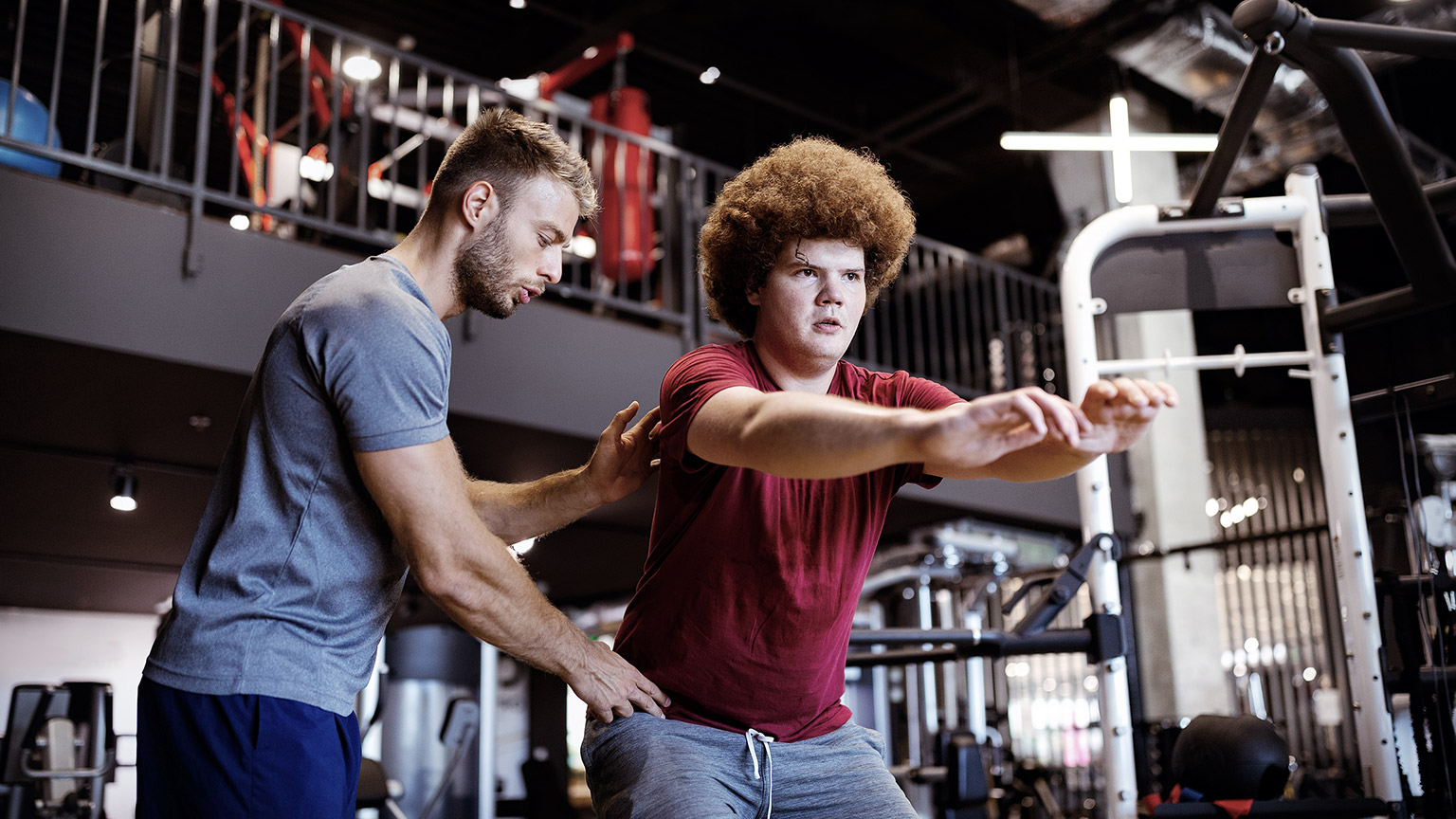Welcome to Exercise adherence! Exercise adherence is the ability to stick to a regular exercise routine over time, and it is a crucial factor in achieving health and fitness goals. In this topic, we’ll recap on understanding human behaviour relating to changing client’s habits to achieve long-term health and wellness. You will also learn about common barriers and the skills to motivate your clients to adhere to exercise independently.
We’ll cover:
- Understanding human behaviour
- Factors effecting exercise adherence
- Strategies for exercise adherence
Behaviour
Behaviour is how we act. It is a response to:
- thoughts and feelings.
- the environment, including other people (NSW Health, 2020).
Behaviour is the expression of our conscious and subconscious decisions. For example:
- the way we express (or don’t express) how we feel.
- the thoughts we act upon and how we act upon them.
Over time, the continuation of these decisions (from the small ones to the big ones) form our behaviour.
The cognitive triangle
Cognitive behavioural therapy (CBT) considers how thoughts, emotions, and behaviour are linked. In simple terms, how we perceive a situation (our thoughts) will influence our response (emotions and behaviour), more than the situation itself (Beck Institute, n.d.).
The cognitive triangle illustrates the relationship between thoughts, emotions, and behaviour that underpins CBT.
(KASA Team, n.d.)
Let’s look at a few scenarios. In each scenario, consider how your thoughts impact your emotions and behaviour. And how in turn, your behaviour and emotions reinforce thoughts.
Scenario 1
You have a stressful situation coming up. You wake up thinking about it and can’t shake your worry. You have feelings of anxiety. How might this affect your behaviour throughout the day and in social situations?
Scenario 2
You are feeling really good and energised after a great sleep. You look at yourself in the mirror and think “Yeah, I’m going to crush my goals today.” You think more optimistically about the day. How are your emotions and behaviour influenced?
Scenario 3
You don’t go to the gym as planned and feel guilty. You start to have negative self-talk, and this leads to more negativity. How did your perception of missing the gym – your thoughts – impact your emotions? What behaviour might result from this?
Scenario 4
You think about achieving a major exercise goal, maybe bench pressing 100kgs for the first time or hitting a personal best running. Those thoughts make you feel pumped up, eager and driven to attack your workout. Your behaviour and emotions are conducive to better performance within the workout.

We are the stories we tell ourselves
Decisions are based on thoughts and emotions. But what influences both these things?
- Do you choose what you think? Where do thoughts come from?
- Do you get to decide how you feel? What dictates our feelings?
Emotions and self-awareness change our thoughts.
New positive emotional experiences create consistent positive emotions. At some point, this will be assimilated into new thoughts.
What we pay attention to grows
We can decide which thoughts we must pay attention to. You can change, enhance, and alter your perspective on things! Let’s do an activity to illustrate.
Grab a piece of paper or pull up a note on your computer or phone. Write down everything that comes into your head for 1 minute.
Where did those thoughts come from?
Now get ready to listen. Write down everything you can hear for 1 minute.
You may have thoughts like, “That humming would be annoying I if was focusing on it the whole time. I never noticed that before.” It’s not always easy. And for some, it is harder than for others. But with practice, you can choose what thoughts you want to focus on.
Experiences dictate our emotions
As a coach, you are in the experience industry, not the fitness industry.
You’ve seen the stats. Most people aren’t physically active. They don't like going to the gym. Even if they know it’s good for them.
But you have the power to manipulate the experience of every client positively. If you optimise the experience to align with a positive emotional outcome, then you lay the foundation for a behaviour change. And this leads to more performance or goal-orientated successes… and more happiness!
Repeated new experiences lead to a change in emotional interpretation and new feelings being generated.
When trying to develop healthy habits, we should focus on rewarding the behaviour instead of the outcome.Dan Ariely – Professor of Psychology and Behavioural Economics, Duke University
You’ll learn more about successful client consultations and creating optimal workout experiences in Exercise Prescription Parts A and B and Special Populations and Exercise Adherence.
Decision Making
Change is not linear. There are stages to decision making and change. Recognising what stage your client is in helps you help them.
Stages of change
The Stages of Change Model (also known as the Transtheoretical Model or Prochaska’s Model) defines 6 stages of change.
The model was developed in 1986 by Prochaska and DiClemente as a way of understanding how some people can quit smoking easily and independently, while others need greater support.
Nowadays this model is applied to a broad range of behaviours.
The model is widely used in the health and fitness industry to understand where clients are in relation to making new habits and sustained behavioural change. Use this model to guide you in how you choose to motivate your clients.
Each stage of Prochaska's Model has principles and processes to support change. The time a client may spend in each stage is variable, but the steps to move on to the next stage are not. Certain tasks and principles of change are better suited to some stages than others. These tasks and principles are designed to reduce resistance, encourage and support progress and avoid reverting to old habits.
1. Precontemplation
People in this stage are not yet thinking seriously about making any changes and are not looking for help. They may be defensive about their level of health and fitness or not feel it is a problem. They are unlikely to consider making changes within the next six months.
Your goal is to:
- Help your client develop a reason for changing
- Validate their experience
- Encourage further self-exploration
- Leave the door open for future conversations – “plant the seed”.
2. Contemplation
Your client is more aware of the personal consequences of the behaviour in question. They spend time thinking about their problem but cannot consider the possibility of changing. They may appear ambivalent. They may doubt that the long-term benefits of a change will outweigh the short-term costs.
Your goal is to:
- Validate their experience
- Clarify their perceptions of the pros and cons of behavioural change
- Encourage further self-exploration
- Leave the door open for moving to preparation.
3. Preparation
Your client has committed to making a change. This could present in the form of researching what they need to do to make a change. Often people will move directly from contemplation into action, skipping preparation. This frequently leads to failure because they haven’t adequately researched or accepted what it will take to make a major lifestyle change.
Your goal is to:
- Praise the decision to change behaviour
- Prioritise behaviour change opportunities
- Identify and assist in problem-solving and overcoming obstacles
- Encourage small initial steps
- Encourage identification of social supports.
4. Action
Your client believes they can change their behaviour and are actively taking steps to do so. They review their commitment to themselves and develop plans to deal with pressures that may lead to slips. They may use short-term rewards to sustain their motivation and analyse their behaviour change efforts in a way that enhances their self-confidence.
There is a risk of relapse, so it is important to keep providing encouragement and motivation.
Your goal is to:
- Guide and help implement action towards the goal
- Provide encouragement and motivation
- Identify and assist in problem-solving – remind the client of their end goals
- Acknowledge successes
- Monitor progress.
5a. Maintenance
Your client has adopted new behaviours and is aiming to maintain these.
Effective preparation in earlier stages means your client can anticipate situations that could lead to a relapse and develop coping strategies.
They remain aware that what they are striving for is personally worthwhile and meaningful. They are patient with themselves, recognising that it often takes a while to let achieve sustained behavioural change.
Your goal as the exercise professional is to:
- Encourage adherence to the programme
- Monitor progress.
5b. Transcendence or termination
Some researchers add the stage of transcendence or termination to the model. This is a stage where the client has no desire to return to the past behaviours and is confident they will not relapse. This stage is rarely reached, with people staying in the maintenance stage long-term.
6. Relapse
The path to successful and sustained behavioural change is full of obstacles. Even the most dedicated individual may experience a relapse. It is common to have at least one relapse, often accompanied by feelings of disappointment and failure.
While relapse can be discouraging, it is important to note that the journey to change is not a straight path. Individuals will naturally cycle between the stages several times before achieving maintenance or termination.
The following video provides an overview of the Stages of Change Model. Watch the video and consider how this could be used with clients and yourself to succeed with behavioural modification.
Facilitating positive behaviour modification
Facilitating behaviour change in others is hard. You won’t always get it right. Things that you can’t control will influence your client. However, if you support your client using the suggested goals for each stage, you can optimise your client’s experience for a positive outcome.
- Build rapport and trust
- Do your best to find out what motivates your client, what they enjoy and their reasons for change
- Consistently try to optimise your interactions to ensure maximum satisfaction from your client
- Your client is more likely to continue training with you, and the biggest #gains in mental and physical health are to be made.
Scenarios
It’s time to apply the Stages of Change Model to some real scenarios you may encounter as a personal trainer.
- Identify what stage of change is exhibited in each scenario.
- List any potential emotions the client could be feeling.
- Determine the likelihood of the client’s decision to continue based on the interaction between the client and trainer.
Scenario A
Scenario B
Motivation

Motivation is the reason we do something. It's what inspires us to behave a particular way or to make a specific decision. There are two types of motivation – intrinsic and extrinsic.
Extrinsic motivation is when we are motivated by external forces such as rewards or punishment.
You may have heard this referred to as the carrot and stick approach. The phrase comes from the idea of getting a donkey to move forward by either dangling a carrot in front of it or hitting it with a stick if it does not move. The donkey is motivated to behave a particular way because it either thinks it will be rewarded (with a carrot) or for fear of punishment (the stick).
Extrinsic rewards include things such as money, praise from others, promotions, good grades, and awards. Extrinsic punishments could include negative performance reviews, demotions, losing privileges, social isolation (time-outs), and poor grades.
Intrinsic motivation is doing something purely for enjoyment or interest in the activity.
Take your approach to study. If you are only motivated to complete a module to get a good grade on an assessment, receive praise from a tutor, graduate, and get a well-paid job, we could say you are extrinsically motivated.
However, if you are motivated to complete a module because you enjoy learning and developing your skills, find the topic interesting, and get enjoyment and a sense of fulfilment from what you achieve, we could say you are intrinsically motivated.
One is not better than the other. You will probably find that you are sometimes motivated extrinsically and sometimes intrinsically. A combination is likely the best.
Write down as many extrinsic and intrinsic motivators you can you think of in a health and fitness setting.

Motivation components
Different people tend to gravitate towards either intrinsic or extrinsic motivation. However, our motivations are not fixed. What motivates you today may change tomorrow. You may be extrinsically motivated at work but intrinsically motivated when working on your own fitness goals.
Other components of motivation include:
| Direction | The goal that an individual is working toward. The goal keeps the client focussed and forward-thinking (i.e., gives direction), and is therefore motivated. Goals may be set by the individual (intrinsic) or by the fitness professional (extrinsic). |
|---|---|
| Intensity | The level of effort an individual is willing to apply to attain their goal/s. People tend to display higher levels of intensity if they perceive an outcome as being readily achievable. |
| Persistence | The duration of time in which a person is willing to apply effort (intensity) to work towards their goals (direction). |
When discussing client goals, you should try to identify:
- what type of motivation the client is exhibiting - intrinsic or extrinsic.
- the specific goal that is motivating them to undertake the activity.
- how committed they are to achieving the goal.
- what ongoing behavioural changes they are willing to make once the initial goal is achieved.
Adapting your communication style depending on these factors will help. E.g., an intrinsically motivated client may not need as much verbal praise or tangible rewards and may not appreciate grand public displays of achievement celebration. Whereas extrinsically motivated clients may thrive on these rewards.
Spotlight on Industry

Maia is a group fitness instructor for Elev8 Fitness Club.
Her responsibilities include:
- leading group fitness classes.
- teaching members the proper techniques for participating in classes.
- tailoring each class to the group.
- paying attention to people’s age, fitness levels, and any injuries or health concerns.
Elev8 Fitness Club offers group fitness classes from high intensity to gentle reconditioning and everything in between.
Can you briefly describe the process of instructing a group fitness class?
“This begins with developing a plan beforehand, and then instructing the class so that they know the what, when, how, and where. I observe everyone, throughout the workout, for correct technique and level of intensity. I need to be prepared to adapt or modify the session plan because of the needs of one or more people on the day. I may need to lower the intensity of the exercises or raise it; I may have to change the music that I chose or decide not to play music at all; I may have to adapt equipment used. I always request feedback so that I am confident that what I am doing is working for the members.”
How do you know if the class is working out to the level that's needed?
“That’s done by monitoring exercise intensity. If I am leading a class that uses equipment with built-in heart rate monitors, then it’s simply a matter of checking heart rates against target heart rates. I can also use the ‘Talk Test’, which means, if people can talk while exercising and not lose their breath then they are not exercising hard enough. There is also the ‘Exertion rating scale’ where I can observe and rate physical signs of exertion to gauge if they need a rest or need to work harder.
On the other hand, I must monitor for and avoid over-exertion. Extreme breathlessness, extreme perspiration, dizziness, nausea, pain, pressure around the chest or in the arm, and breathing problems. Any one of these things would be classed as an emergency.”
How do you communicate your exercise plan to the group?
“I demonstrate the exercises. I perform them in front of the class slowly while talking through what I am showing them with clear verbal instructions. Precise and to the point. I don't give long-winded explanations. I follow this with a demonstration in real-time at a normal pace.
During the class, I demonstrate next actions while participants are continuing with current actions. I give hand signs or verbal cues when an activity is to change. And I don't have the music on too loud, the class needs to hear their instructor.”
Do the members in your class need you to motivate them?
“Yes, of course they do. Not many people will come to a fitness class ready to go and even if they do, it’s very hard to sustain that feeling right through the session without some help. There are some techniques that I use, such as, remaining upbeat throughout, using music, varying the exercise to make it fun, slowing down or speeding up, providing encouragement and support, always celebrating their achievements. I want them to return to my next class so I create high-energy classes and have different routines each time.”
Motivational Strategies
Motivational strategies can be used to promote behaviour change for your clients. Aligning the most appropriate method for individual clients is part of the responsibilities of a good personal trainer. Using the correct strategy will result in an increased overall success rate and high client satisfaction levels.

Motivational strategies include:
- Contracting
- Prompts
- Reinforcement
- Perceived choice
- Feedback
- Self-monitoring
- Social support
- Decision balance sheet
- Physical setting
- Exercise variety
- Group training
- Minimised discomfort and injury
- Enjoyment
- Assessments and progress
To read about each strategy, click to expand.
An exercise contract is a written agreement between a trainer and a client. It seeks to address specified behaviours within an agreed timeframe. Some people require the formality of a written document to keep them motivated.
Prompts are a method of using words, visual signs or notes, technological devices, and actions to remind a person to complete a task or participate in an activity. They help change behaviour by establishing routine habits.
Some examples of prompts include:
- using certain words at the start of a fitness class.
- regularly reminding clients to stretch before and after exercise
- sending out reminder messages.
- leading by example to prompt the client to respond and react in a certain way.
- a sign that reminds them that towels are mandatory when using resistance machines.
Reinforcements to an exercise routine are reward systems set in place to help participants to complete their training routines to reach their exercise goals. They can be external rewards (positive reinforcement), internal rewards, or negative reinforcement (punishment).
Negative reinforcement is not recommended and should only be used in extreme circumstances, such as aggression or excessive rule-breaking.
Providing the client with a range of choices will improve the success rate. It could be the choice between two types of exercise equipment, the time of day in which the session is scheduled, or intensity level adjustments. People with a feeling of control and/or input regarding how the decision was reached are often more satisfied.
Feedback is a great tool to promote changes to exercise behaviour as it can be constructive or motivational and can be used to shape how the participant responds to the program.
Self-monitoring should be encouraged in participants. Participants must be encouraged to observe and rate their behaviour consistently.
There are a variety of apps and devices which can help with self-monitoring, including wearable technology.
People need and thrive on social support, and this can come in the form of numerous types of social networks, including family, friends, colleagues, mentors, and personal trainers. When clients know that people care about them, it helps them maintain a positive outlook and mental wellbeing.
A decision balance sheet is essentially writing a pros and cons list. This may help with decision-making, providing focus, and motivation.
The physical setting that exercise takes place in can create a motivating or demotivating environment. This can result in a mindset change for the client. It is important that the physical setting:
- has natural light and adequate lighting from other sources.
- is a clean, uncluttered environment with a logical floor plan and plenty of space for individuals to exercise without crowding.
- has good air circulation allowing for comfortable air temperatures and clean air.
- reducing boredom and resentment.
- creating a sense of fun and adventure.
- providing new challenges.
Teach your clients the importance of correct technique, the value of flexibility exercises, and avoiding overexertion. This will help to minimise discomfort and injury so that exercise is associated with positive thoughts and memories rather than negative pain-related ones.
Exercise groups can act as a social network for some people, providing support, conversation, and inspiration. Friendly competition can also be utilised as a means of motivation.
Discover what a client enjoys doing and create an exercise program to suit. This will result in a higher success rate. The following tools can help you figure out what your client enjoys.
- Surveys
- Interviews
- General conversation
- Feedback forms
- Client reviews on public forums
Achieving a result and having it officially recorded helps to provide a visual confirmation of progress. Individuals will have an intrinsic boost to motivation as they have achieved a personal goal and the proof of their success is clearly available.
Regular fitness assessments should be scheduled every 3- to 6-months. Too frequent, and the assessments will not be motivating as progress will not be evident yet, but too far apart and enthusiasm may wane.

As an exercise coach, you'll need to develop skills that significantly influence and support your clients. These skills relate to how you interact with your clients, introduce exercises, and set them up for long-term success. You want your client to sustain a positive relationship with exercise and nutrition.
By getting to know your client’s building a strong rapport with your clients, you will be able to determine your client’s needs, limitations, barriers, goals, and even their excuses for not exercising. This will allow you to provide personalised support by identifying which strategies will be most useful and guide them towards achieving exercise adherence.
Practical recommendations
There are many ways in which you can support your client to balance the obstacles which life can present. The following are some practical recommendations to guide you in effectively supporting your clients and achieving exercise adherence.
- Positive reinforcement of desirable behaviours.
- Provision and encouragement of social interaction. E.g. group exercises, group Personal training.
- Discussion of barriers and strategies to overcome them.
- Provision of specific individualised feedback.
- Prevention of disruptions to training.
- Improving enjoyment through tailoring activities to client preferences and adding variety.
- Positive feedback.
- Stay in touch with your client. E.g. via Phone calls, texts and emails.
- Discuss barriers and help find solutions.
- Revisit client’s initial goals and aims.
- Re-emphasise the importance of exercise and how it will benefit them.
- Adaptations to the programme to suit client needs.
- Discuss ways your client can gain family support or participate in exercises together. E.g., kids bike ride while your client jogs or power walks.
- Discuss and agree on an established routine that the client can achieve independently.
Don’t forget, avoiding injuries can also mean that there is less chance for relapse as they can maintain consistency with exercising. The following describes ways to prevent injuries to a variety of special population clients.
Preventing injuries
When it comes to preventing injuries for obese, ill, elderly, and pregnant clients, there are a few things to keep in mind.
Firstly, it's important to start with proper screening and assessment to determine the client's health status and any potential risk factors that could lead to injuries. Once you have this information, you can create a customised exercise plan that takes into consideration their individual needs and limitations.
For obese clients: It is recommended to include low-impact exercises that are easier on the joints, such as walking or swimming, may be more appropriate. Additionally, it's important to ensure that any equipment being used can accommodate their weight and size.
For ill or elderly clients: It's important to focus on exercises that improve strength, balance, and flexibility. These exercises can help prevent falls, which are a common cause of injury for these populations.
For pregnant clients: Include exercises that are low-impact and not too strenuous are usually recommended. It's important to avoid any exercises that could increase the risk of falls or put too much pressure on the abdomen.
In general, it's important to start slowly and gradually increase the intensity and duration of the workout over time. Encouraging proper form and technique is also crucial to prevent injuries. Remember, communication is key. Encourage clients to speak up if they experience any pain or discomfort during a workout, so that you can adjust the programme accordingly.
A few extra tips to avoid injuries on your clients during exercise include:
- a proper warm-up is performed
- appropriate exercise attire is worn
- the environment is suitable for the session
- the client is monitored at all times during the session
- adequate hydration and rest are achieved and look for “danger signs”, chest pain, dizziness etc.
Implementing strategies
Our greatest weakness lies in giving up. The most certain way to succeed is always to try just one more time.Thomas Edison
As an exercise professional, it's important to help your clients prepare for situations that could lead to them stopping their exercise routine, or "relapsing." Instead of seeing these moments as failures, they should be viewed as challenges that are bound to happen from time to time. For example, during the winter months, it can be tempting to stop exercising because it's too cold outside.
It's crucial to educate clients on how to deal with these moments of relapse so they can adhere to exercise.
Here are some strategies that can enhance the practical recommendations and further support your client with exercise adherence.
Identify barriers
Identify barriers that can trigger a relapse. For example, if you know that your client’s busy work schedule causes them to skip workouts, you can plan ahead and schedule your client’s exercise sessions at a different time or on a different day.
Explaining benefits of exercising
One approach to motivating our clients is by educating them. It may help your client to know how exercise exercise benefits them.
Here are some ways exercise can be beneficial to clients. See if you can determine which apply to specific special population clients.
| Immediate benefits (brain health) | “Benefits include improved thinking or cognition for children 6 to 13 years of age and reduced short-term feelings of anxiety for adults. Regular physical activity can help keep your thinking, learning, and judgment skills sharp as you age. It can also reduce your risk of depression and anxiety and help you sleep better.” (CDC, 2022) |
| Weight management | Exercise can assist in both maintaining and losing weight. |
| Reduce health risk | Being physically active lowers your risk for developing several common cancers along with reducing the risk of cardiovascular diseases and diabetes. |
| Strengthen bones and muscles | “This is important for older adults who experience reduced muscle mass and muscle strength with aging. Slowly increasing the amount of weight and number of repetitions you do as part of muscle strengthening activities will give you even more benefits, no matter your age.” (CDC, 2022) |
| Improve physical ability prevents falls | By implementing activities such as aerobic, muscle strengthening, and balance training, you can help prevent falls, in particularly for elderly clients. |
| Increase your chances of living longer | An increase in movement and steps for older age groups can enhance your years of life. |
| Manage chronic health conditions & disabilities | “Helps clients manage existing chronic conditions and disabilities. For example, regular physical activity can:
|
(CDC, 2022)
Watch
Check out the following Ted Talk by Wendy Suzuki.
She's a neuroscientist who explains how exercise can benefit you in a lot of different ways, including protecting your brain from diseases. This really inspiring talk highlights how even just one minute of movement everyday can make a difference. Take note of the immediate benefits that can be used to assist clients with motivation and adherence.
Set realistic goals
You want to set your client up for success. This means their goals need to be realistic. Setting unrealistic goals can be overwhelming and lead to frustration. Work with your client to set achievable and realistic goals that align with their fitness level, lifestyle and consider any existing conditions.
Motivate your clients
You may ask yourself… “How can I motivate my clients to maintain a personal fitness programme?”
To motivate your clients, there are a few things you can do. The first thing to know is that you'll need to help them stay motivated not just at the beginning of their programme, but also during and after it. That way, they'll be able to keep up with their exercise routine on their own.
To get started, there are a few strategies you can use to motivate your clients, and it's important to find what works best for each individual. Motivating your clients starts with finding the right approach for them and helping them stay on track throughout their fitness journey.
Develop a support system
Have your client set up their own support system. Sometimes having family and friends to hold your client accountable can be an excellent way for them to stay motivated. To implement exercise long turn, you can discuss with your client ways that different support systems may work for them. For instance, clients can:
- join a fitness group.
- find a workout buddy.
- scheduling regular check-ins with you.
- join mothers groups that work out together and/or with their children.
- jog while their children ride their bikes.
- use social media to connect with like-minded people.
- join a community of exercise groups.
- gain support of family, friends and co-workers (preferably sought from the beginning).
Programmes where people exercise alone compare poorly with those programmes incorporating group dynamics in terms of adherence rates.
The commitments made as part of a group tend to be stronger than those made independently. The social support provided by others may offer the incentive to continue even during periods of sagging interest.
Create a plan
Have you ever realised that a missed day at the gym can turn into weeks or months without returning? This is because you need to have a plan and stick to it!
Develop a plan for your client that outlines specific actions they can take when they experience a setback or a relapse. For example, if they miss a workout, plan to make up for it the next day or do a shorter workout at home. Help your clients to develop a growth mindset and view setbacks as opportunities for learning and improvement. Creating this mindset is the best way to set you client up with the independent skills to adhere to their exercise without reliance of others.
Find out what motivational strategy works for them and have them motivate and push themselves to continue with their exercise.
Celebrate successes
It is nice when you celebrate your client’s successes. But teach them to also celebrate their successes along the way, no matter how small they may be. This can help them stay motivated and reinforce positive behaviours.
Remember, preventing a relapse and adhering to exercise is not always easy, but with the right support and strategies, it is possible to maintain a consistent exercise routine and achieve your fitness goals.
